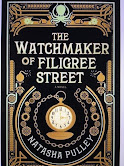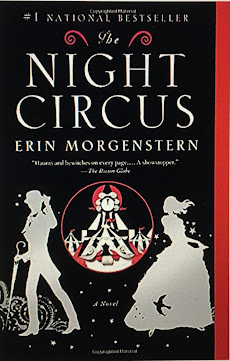A Celebration of Language
Book review by Theresa Gauthier
The Watchmaker of Filigree Street by Natasha Pulley
This is a book dripping with atmosphere. Mysterious, Victorian, in some ways Sherlockian—though admittedly that’s a superficial comparison—the book is one that begs to be savored, read in slow, mindful minutes with complete attention to each and every word. At the same time, it’s such a compelling read that I couldn’t stop myself from staying up until 1:00 AM to finish it.
Opening in London in 1883, the story begins with Nathaniel Steepleton, referred to after his introduction as Thaniel. The reader is treated to a description of Thaniel’s life and also of his feelings about that life. You begin to understand that Thaniel has given up a lot for the blessing of steady work, and the mundane sameness of his day-to-day life, if extrapolated from the fact that it takes him twenty-one minutes to dress and get ready for work, is weighing on him almost as much as the thought of what he’s given up to support his widowed sister and her sons.
His routine is so practiced and unchanged from morning to morning that Pulley describes it:
It was so well established that if he tried to do anything
unusual or go any more slowly, he felt a pressure on the
base of his skull.
His life and work have provided enough, but just enough.
He was not poor—he could afford ten candles and two
baths a week. He wasn’t going to throw himself in the
Thames for the misery of it all, and God knew most of
London was worse off. All the same, he had a feeling
that life should not have been about ten candles and
two baths a week.
Yet, amidst his ordinary world, Thaniel himself is anything but ordinary. A synesthete, he can see sound. He describes sounds in colors. For instance, the staircase where he works sounds yellow.
As he went down, it clanged in a bright yellow D sharp.
He couldn’t say why D sharp was yellow. Other notes
had their own colors.
Arriving home from work one evening, Thaniel discovers a velvet box with a white ribbon and a card addressed to him. Inside he finds a pocket watch. Beautiful, of an intricate design, and a rosy-gold, the watch is the harbinger of change.
The story takes off from here. He’s puzzled over the appearance of a watch he cannot even open. Some time later it opens of its own accord to reveal a card with the watchmaker’s name. It’s keeping perfect time, and only when the watch saves his life does he go in search of the Watchmaker on Filigree Street.
His life begins to change now, and the mysterious Mr. Mori, a Japanese nobleman turned watchmaker becomes an important part of the events. The roles of fate and chance begin to blur the more you learn about Mori, and you can’t help but be as curious as Thaniel is about the man.
Mori is unique in his own way. As Thaniel is a synesthete, Mori has his own unusual ability. It is this ability that colors how others view him. Thaniel will have his own loyalties tested the more he learns of his new friend.
Bombings, betrayals, suspicions, prejudices, nationalism, the preconceived notions of society—whether right or wrong—all play a part in the tone and intricacies of the story.
The thing I love most about the book is the language. The author has chosen words, phrases, and cadence that set the tone and mood of the story. Using words the way a painter uses paint, she proves herself a master of the art of writing.
Similar in tone and weight to Jonathan Strange and Mr. Norell by Susanna Clarke and The Night Circus by Erin Morgenstern, The Watchmaker of Filigree Street has become one of my favorites and is a book I take great pleasure in recommending.







Comments
Post a Comment